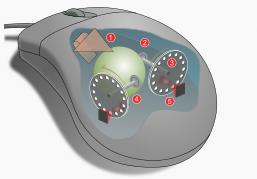Chapter 7: Mice
Clean mice as all other plastic computer equipment, do not bend LEDs and photodetectors inside if you don't know
what do you want to tune. If you don't remember ball-based mice, you should know
that these shafts which are rotated with ball should not be covered with dirt.
In some mice it may be needed to replace microswitches (especially Amiga mice or
late-90s PC mice made by Genius).
Mouse works by translating moves to electric signals. Ball rolls and
actuates horizontal and vertical shafts. These shafts rotate discs with
holes. The se discs pass and interrupt lighs from infrared LEDs to
phototransistors so the speed can be figured out from the signal.
The direction of move is detected by using two detectors in some
distance. When the change (light interrupt) is detected on one detector
first, the directioin is forward, if the second goes first - backward.
Sometimes two detectors are combined in one casing, in other cases it is
made using two LED-phototransistor parts on both sides of the disc.
Alternating waves can be converted to digital form and passed to
computer or converter to data packets by mouse electronics and sent to
PC by some serial connection.
So if your mouse works perfectly when opened, but closed casing
makes it not work it means that light doesn't pass to detector. You can tune it
moving one of problematic LEDs/detectors a bit.
Before, check do the LEDs work. They emit infrared, so it won't be possible to
see their emission, but some cheap CMOS cameras can convert it to visible traces
on a photo - just see these LEDs in a dark room using a cell-phone camera.
|

Principle of operation of a typical computer mouse
Source:
Wikipedia |
There are many kinds of computer mice interfaces. Examples are:
1. Serial port - the most common in old PCs, before PS/2 port
era, mouse with female DB9 connector. These mice will work usually only with
PCs, in DOS they need a driver. Serial port is a connection which is used to get
information to computer, but information may be packed in different "languages".
There are two of serial mouse standards: "Microsoft" one (or "Logitech",
"Dexxa", etc.) being a de-facto standard, or older "Mouse Systems PC Mouse"
standard which is different and requires another driver. If you plan to run
certain old software (such as VisiCorp Visi-On) on your PC you may need the
mouse with PC Mouse standard. Some mice have a switch allowing to switch between
"Microsoft" (2-button) and "PC Mouse" (3-button) modes. Sometimes this switching
can be done by holding the left mouse button at the power-up of the system.
2. Phase detection - this mouse sends four square waves, a
pair for each direction. The shift between these waves is interpreted as cursor
moves. These mice are not common in PCs (probably only early Microsoft Bus Mouse
is such animal, and it requires a special ISA expansion card), but they are
standard in early Macintosh (before ADB), Amiga or Atari ST, maybe early Siemens
PCs. My universal mouse
is such mouse which can be made of any old computer mouse.
3. Key pressing - These are rare and specific for a computer
model. Moving in specific direction gives pulses on specific data lines or
toggling specific keyboard scan codes. They were used only in some rare PC
clones and early Amstrad PCs.
4. Analog - Mouse emulates a paddles with analog knobs. The
only usage of this method I know is some strange
Commodore 64
mouse.
5. ADB - Special interface designed for keyboard and mice in
early (pre-USB) Apple Macintosh computers.
6. PS/2 - mouse and keyboard interface for IBM PS/2 and PS/1
computers, later spread to all PCs instead of serial port. Some PS/2 mice may
work as a serial mice with a converter, but not all.
7. Other proprietary connections - e.g. Sun's mice connected
to keyboard - they are usually some serial connections, but require the proper
hardware.
These interfaces are not interchangeable without active (usually
microprocessor-based) converters. Phase detection mice can be usually connected
to another machine but only when special pinout converter is made.
MOUSE Diagnostic checklist:
0. Clean it. Especially rollers and shafts. Works better?
1. Check cable with ohmmeter. If doesn't work, in 90% cases it needs to be cut
and re-soldered, and the break is near mouse. I usually cut it leaving 6-10cm in
mouse, then re-solder it to mouse's internal connector's plug. having a few cm
of wires left from it.
2. If it still doesn't work, try touching chip on PCB.Maybe a broken solder?
3. If it's still not detected, suspect other broken solders or electronics. IF
it is detected, but cursor is not moving...
4. Rotate the X/Y wheels by hand - test axes. Try to slightly (!) move receiver
(receiver is not transparent) spinning the wheel in a good lit environment -
does it move cursor? If it looks like it works, try to calibrate it by moving
the receiver.
5. If it works in light, but doesn't when mouse is closed, the culprit is
transmitter's position. Usually too close to wheel.
6. Check button contacts, do they require resoldering or replacing?
7. Bad solders on transmitters/receivers?
8. Now you can suspect electronics.
MCbx, 2016


